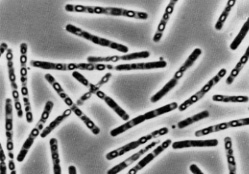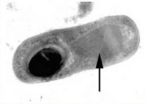Bacillus thuringiensis
A Microbial Biorealm page on the genus Bacillus thuringiensis
Classification
Higher order taxa
Eubacteria (kingdom); Bacteria (domain); Firmicutes (phylum); Bacilli (class); Bacillales (order); Bacillaceae (family); Bacillus (genus)[2]; Bacillus cereus group
Species
Bacillus thuringiensis
Description and significance
Describe the appearance, habitat, etc. of the organism, and why it is important enough to have its genome sequenced. Describe how and where it was isolated. Include a picture or two (with sources) if you can find them.
B. thuringiensis is a gram positive, soil-dwelling, spore-forming, rod-shaped bacteria. It produces crystal proteins (cry proteins) and uses it to fend off insects, predators, and other pathogens.[3] [4]
It's genome was completely sequenced fairly recently (February 23rd, 2007) [6]. It is critical to have B. thuringiensis' genome sequenced because it has many benefits for humans in the form of agriculture. Farmers frequently use it as a pesticide for their crops to fend off insects. Having sequenced the entire genome, scientists can witness and determine how mutations can create different variant strains which may eventually grow stronger against antibiotic pests. What's great about B. thuringiensis pesticide is that the S-layer it produces (where the Cry protein and toxins lie) has no known negative effects on humans, vertebrates, or plants.[7]
http://pmep.cce.cornell.edu/profiles/extoxnet/24d-captan/bt-ext.html
Genome structure
Describe the size and content of the genome. How many chromosomes? Circular or linear? Other interesting features? What is known about its sequence? Does it have any plasmids? Are they important to the organism's lifestyle?
B. thuringiensis has a circular plasmid chromosome. Due to its 2% GC-content, it has more A/G base pairs. Compared to its bacterial relatives, Bt's genome is not big at all. It genome is only 5,475 nucleotides long, has approximately 2.4 to 5.7 million base pairs [8], and consists of only seven genes: pK1S1_p1, pK1S1_p2, pK1S1_p3, pK1S1_p4, pK1S1_p5, pK1S1_p6, and pK1S1_p7. [9]
Cell structure and metabolism
Describe any interesting features and/or cell structures; how it gains energy; what important molecules it produces.
Ecology
Describe any interactions with other organisms (included eukaryotes), contributions to the environment, effect on environment, etc.
Pathology
How does this organism cause disease? Human, animal, plant hosts? Virulence factors, as well as patient symptoms.
Application to Biotechnology
Does this organism produce any useful compounds or enzymes? What are they and how are they used?
It was once thought that B. thuringiensis' method of toxology was via toxin-mediated disruption, which basically consisted of Bt killing the host by starvation or blood poison. However, recent reserach by scientist at the University of Wisconsin-Madison reported having other players involved.[10]
Current Research
Enter summaries of the most recent research here--at least three required
References
National Center for Biotechnology Information
Edited by Ernest Hsu of Rachel Larsen and Kit Pogliano


